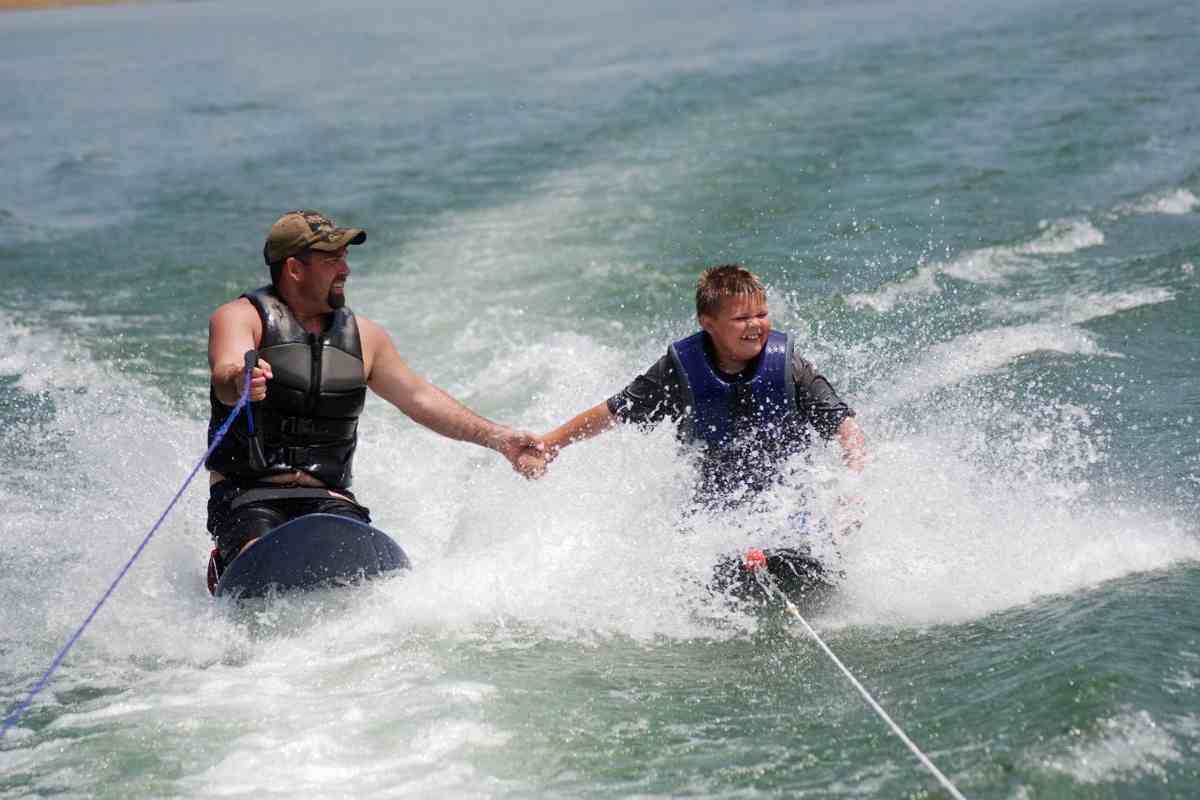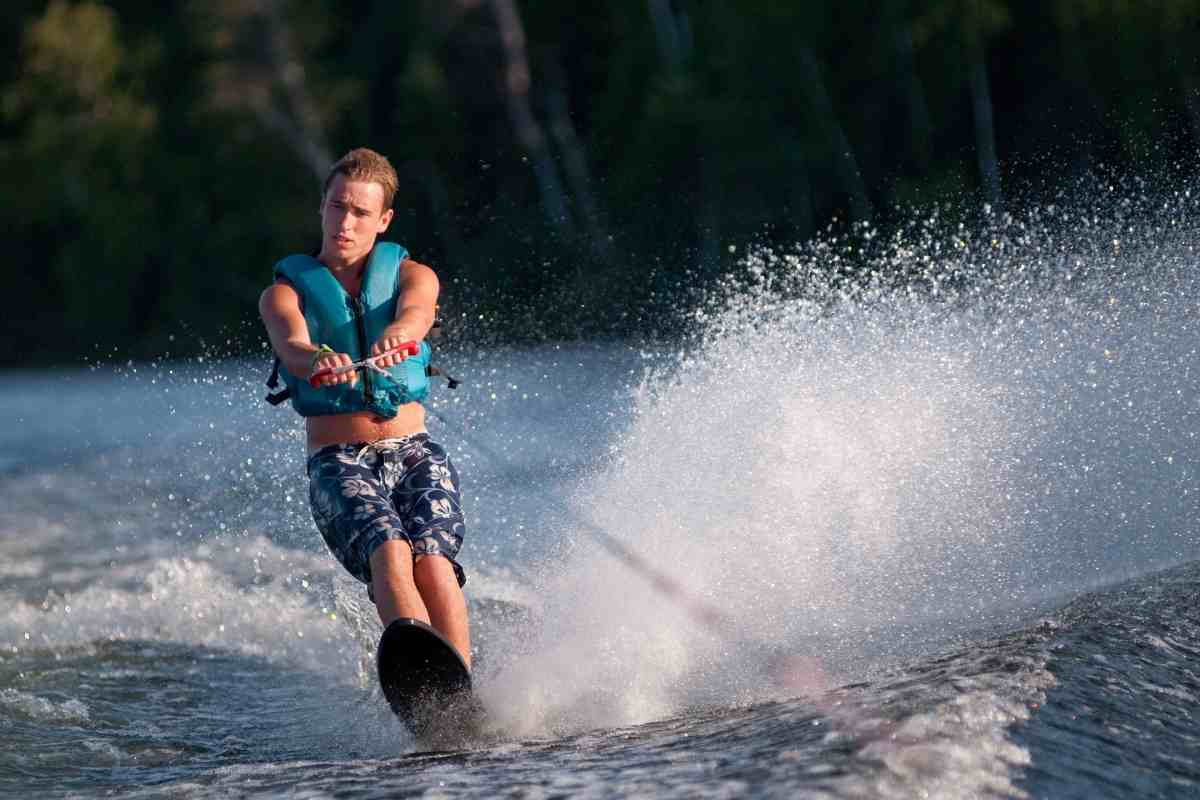Is Knee Boarding Easier Than Water Skiing?
If you have a motorboat that is powerful enough to tow something behind it, you are probably excited to try out some of the water sports that involve being towed, like kneeboarding or water skiing. You may want to base your decision about which sport to start with on how difficult they are compared to one another.
Is knee boarding easier than water skiing? Most people find kneeboarding to be considerably easier than water skiing since you have a lower center of gravity, don’t have to worry about keeping your legs together, and because it uses muscles that you are likely already using in other areas of your life in your core and upper body.
Both kneeboarding and waterskiing can be a lot of fun, but most people find that kneeboarding is a bit easier. Here is an examination into why kneeboarding may be easier as well as some advantages of water skiing over kneeboarding despite its increased difficulty.
What Kneeboarding And Waterskiing Have In Common
Kneeboarding and waterskiing share many of the same requirements, skill sets, and capacity for adrenaline-rushing fun. Both sports require a significant body of water and a boat that can move at reasonably high speeds.
For both, you require a significant amount of balance and control over your body. In both sports, you will start from the water, which means that you can get started again right after you fall off.
You are likely to want a tower for both sports, although it is more important to have a tower for water skiing than it is for kneeboarding. If you have a tower attachment the same height for kneeboarding that you would use for water skiing, you may find that you get a bit more air than you anticipated when kneeboarding. This can be great if you want to pull off great jumps, but it can be a bit intimidating if you hit a wake and aren’t expecting the amount of air that you will get.
Why Kneeboarding May Be Easier Than Water Skiing
There are significant differences between kneeboarding and waterskiing which relate to which is easier for most people. Here are a few of the key differences:
Kneeboarding Requires Less Coordination
When you are kneeboarding, you don’t need to worry about keeping your legs at the appropriate distance from one another or even controlling your ankles or knees very much at all. You will control the board and steer primarily using your hips and upper body. Many people find that the reduced coordination requirements of kneeboarding make it considerably easier.
You Have A Lower Center Of Gravity When Kneeboarding
When you are water skiing, you are standing at full height, which can be considerably more intimidating, especially if you are worried about falling. A higher center of gravity can also make it more challenging to steer and keep your balance. However, when you are kneeboarding, your center of gravity is low over the board and you are naturally centered on the board.
Water Skiing Requires The Use Of Unusual Muscles
When you water ski you need to actively work to keep your legs together, since they will tend to spread out with the water resistance. Most people starting out waterskiing tend to do a split, quickly followed by a face plant.
After even a short time water skiing, you are likely to find that you are sore in muscles that you didn’t even know you had. In everyday life, you practically never feel resistance pushing your legs apart, but this is one of the primary muscle groups that is required when water skiing.
By contrast, when you kneeboard, you are using the muscles in your core, muscles that you would likely use for other activities as well.
It Is Easier To Get Up When Kneeboarding
Both waterskiing and kneeboarding require that you start out at a standstill in the water and then get up on a plane as the boat accelerates. However, many people find it easier to get up on the kneeboard. You start out on a kneeboard with your torso on the board as if you were surfing.
From this position, it is very easy to stay on the board as the boat accelerates. The hard part is tucking your knees into position once the kneeboard is on a plane, but most people are able to master even this more challenging step without much trouble.

By contrast, when you are starting on water skis, you need to focus on keeping your legs together at the same time as keeping your balance as the boat accelerates and the skis get up onto a plane. It can be very hard to balance keeping your legs together and keeping the skis facing straight, especially before the boat is on a plane.
Landing After A Jump Is Easier On A Kneeboard
One of the most fun aspects of kneeboarding or water skiing is taking a jump, either from a wake or a stationary ramp. However, if you can’t easily land after the jump, you may decide that you don’t like jumps very much after all.
Landing after a jump is much easier on the kneeboard since the kneeboard will tend to still be facing in the correct direction after a jump and since your center of gravity is so low. By contrast, landing a jump on water skis can be very challenging, since the skis represent a relatively small surface on which to land, it’s difficult to keep both skis at the proper distance and facing in the right direction during the jump, and your center of gravity is so high.
Ease Of Kneeboarding Vs. Water Skiing Comparison Table
| Kneeboarding | Water Skiing |
| Relatively easy to get up on the board by starting from your stomach and then pulling your knees up onto the board | Takes some practice and muscle development to keep your legs from sliding out into a split or losing control of the skis before you are on a plane |
| Fairly simple to control the board using the muscles in your torso | Can be challenging to keep control of the skis by keeping your legs at the proper distance from each other and keeping both skis facing in the right direction |
| Easy to get a lot of air and land a jump since you have a low center of gravity and the board tends to be facing in the right direction when you land | Fairly difficult to land after a jump since the skis tend to point in different directions during the jump and since you have a high center of gravity |
| Requires the use of muscle you likely use in everyday life in your core and upper body | Requires muscles you rarely use other than when water skiing in your inner thighs to keep your legs together as the water pressure tends to push them apart |
| Doesn’t require as much coordination since you only need to control your waist and upper body and don’t need to worry about your knees or ankles | Demands full-body coordination from your ankles all the way up to your arms to keep the skis facing in the same direction and at the right distance apart. |
What Are The Advantages Of Water Skiing Over Kneeboarding?
If kneeboarding is easier than water skiing for most people, why would you want to water ski at all? There are a few distinct advantages that water skiing has over kneeboarding that are worth taking into consideration if you are deciding which of these sports to get into:
Water Skiing Is A Full Body Workout
You will likely feel very sore when trying water skiing for the first few times, but once your muscles get used to this activity, it is a superb workout for places that otherwise can be difficult to workout outside of the gym, like your inner thighs. It is also a great workout for your core, back, shoulders, and arms. By contrast, kneeboarding is only effective for working out your core and upper body.
Water Skiing Gets Your Head Out Of The Spray
When you are kneeboarding, you are very close to the water, which means that you are more likely to get spray in your face. If you are using a low attachment point, spray that is kicked out from the rope can be a constant irritation in your face. However, even if you are using a high attachment point for the line, you are likely to find that any chop or regular spray over the surface of the water ends up in your face.

Water Skiing May Require More Skill
Some people enjoy water skiing more simply for the fact that it is a bit more difficult. Learning to water ski can be more challenging than learning to kneeboard, but if you are looking for a challenging and rewarding watersport, it can be very enjoyable.
Enjoy Kneeboarding Or Water Skiing
You are very likely to want to experiment with both waterskiing and kneeboarding as you explore the possibilities of water sports that involve being towed behind a powerboat. Both of these activities have provided countless hours of fun and entertainment for all kinds of people throughout the years, and you are very likely to enjoy either one of them or both of them as well. If you are starting out, it may be a good idea to try kneeboarding first, since most people find it easier than water skiing.
